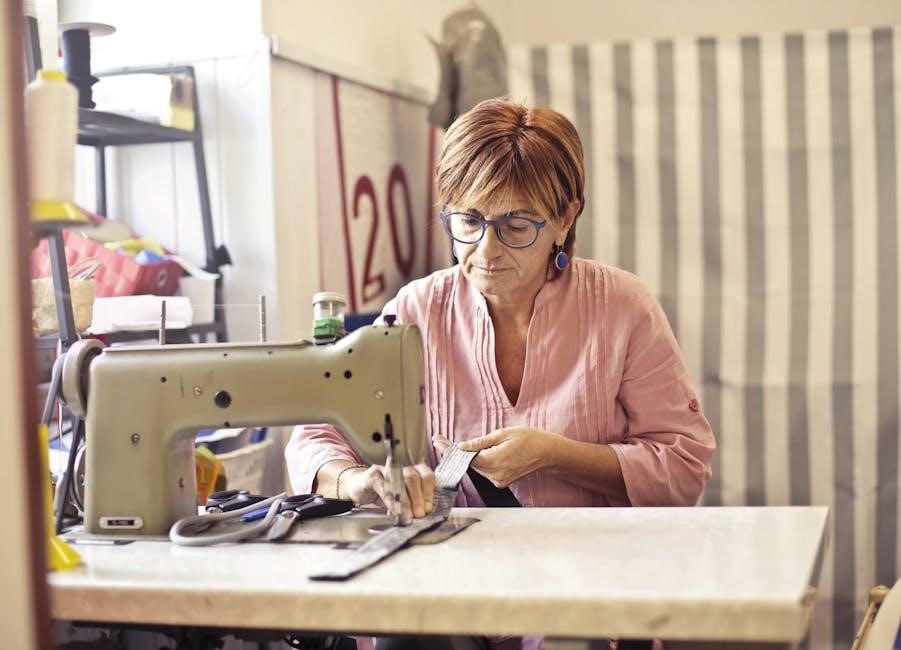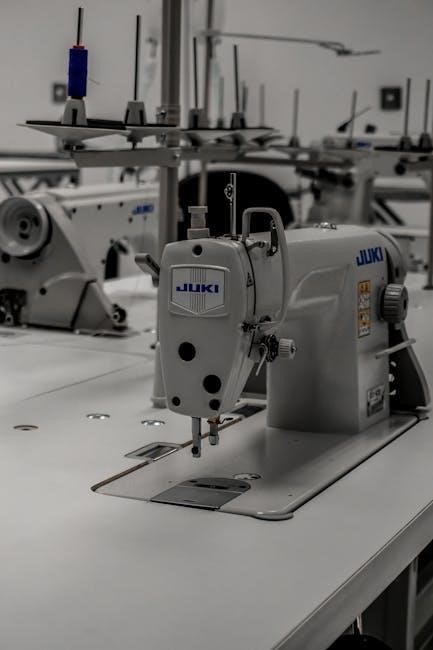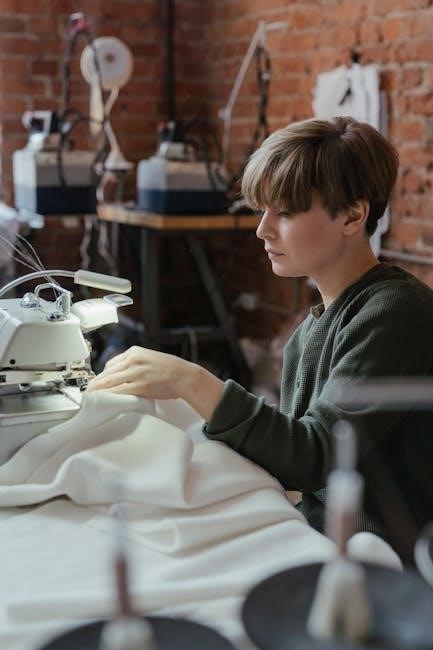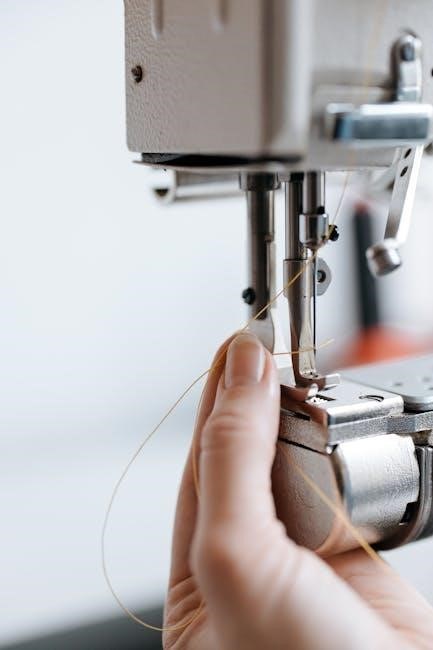Welcome to your sewing machine owner’s manual! This guide provides essential information to help you understand, operate, and maintain your sewing machine effectively. Discover safety tips, setup instructions, and troubleshooting solutions to enhance your sewing experience. Read thoroughly to unlock your machine’s full potential and ensure optimal performance.
1.1 Importance of Reading the Manual
Reading the sewing machine owner’s manual is crucial for understanding your machine’s operation, safety, and maintenance. It provides step-by-step guides for threading, tension adjustment, and troubleshooting common issues. The manual helps you avoid costly mistakes, ensures proper usage, and maximizes your machine’s potential. By following the instructions, you can prevent damage, optimize performance, and enhance your sewing experience. It’s your key to mastering your sewing machine effectively and safely.
1.2 Brief History of Sewing Machines
The sewing machine was first patented in 1846 by Elias Howe, revolutionizing the textile industry. Early models were bulky and limited, but advancements led to portable, user-friendly designs. The introduction of the lockstitch mechanism and subsequent innovations transformed sewing into a faster, more efficient process. Over time, sewing machines evolved to include electronic and computerized features, catering to both industrial and domestic needs. This evolution has made sewing machines indispensable in modern craftsmanship and manufacturing.
Safety Precautions and Guidelines
Always turn off the machine when adjusting needles or cleaning. Keep loose clothing tied back and avoid touching moving parts. Ensure the machine is placed on a stable surface for safe operation.
2.1 General Safety Tips
Always keep children and pets away while operating the machine. Avoid wearing loose jewelry or clothing that could get caught. Ensure the machine is placed on a stable, flat surface. Never touch moving parts with your hands or fingers. Use the correct needle plate to prevent needle breakage. Keep the sewing area clean and well-lit. Regularly inspect the machine for damage or wear. Never pull fabric forcefully through the machine.
2.2 Handling Electrical Components Safely
Always unplug the machine before cleaning or performing maintenance. Avoid using damaged cords or plugs, as they can cause electrical hazards. Keep the machine away from water or moisture to prevent shocks. Never touch electrical components with wet hands. Use only manufacturer-recommended attachments to avoid short circuits. Regularly inspect the power cord for wear and tear. Ensure the machine is grounded properly for safe operation.
Identifying Sewing Machine Parts
Familiarize yourself with your sewing machine’s components, such as the needle, presser foot, bobbin, and feed dogs. Understanding these parts is crucial for effective operation and troubleshooting.
3.1 External Components Overview
The external components of your sewing machine include the spool pin, stitch selector, presser foot, and bobbin area. The spool pin holds the thread, while the stitch selector allows you to choose different patterns. The presser foot controls fabric movement, and the bobbin area manages the lower thread. Familiarizing yourself with these parts ensures proper machine operation and helps you identify potential issues quickly.
3.2 Internal Mechanisms Explanation
The internal mechanisms of your sewing machine include the motor, gear system, and bobbin mechanism. The motor powers the machine, while the gears transmit motion to the needle and presser foot. The bobbin mechanism manages thread flow from the bobbin case. Proper lubrication and regular cleaning of these parts ensure smooth operation and consistent stitching quality. Understanding these internal components helps you maintain and troubleshoot your machine effectively.
Threading and Setting Up the Machine
Properly threading your sewing machine ensures smooth operation. Follow the manual’s step-by-step guide to thread correctly and adjust tension for consistent stitching. This setup is essential for optimal performance.
4.1 Step-by-Step Threading Guide
Start by turning off your machine and locating the spool pin. Place the thread on the spool and gently pull it through the tension discs. Guide the thread through the take-up lever and then insert it into the needle’s eye. Ensure the thread is seated properly in the tension spring. Finally, pull the thread to create slight resistance. Refer to your manual for specific diagrams and details.
4.2 Adjusting Tension for Optimal Stitching
To achieve optimal stitching, turn off your machine and raise the presser foot. Ensure the thread is properly seated in the tension spring. Guide the thread smoothly through the tension discs. Adjust the upper tension dial—tighten for thicker fabrics, loosen for delicate ones. For the bobbin, pull gently to test resistance. Turn the handwheel to ensure the needle moves smoothly. Balanced tension ensures even stitches. Test on scrap fabric; if uneven, adjust settings. Always consult your manual for fabric-specific guidance to master tension adjustment effectively for professional results.

Basic Sewing Operations
Master the fundamentals of sewing with ease. Start with straight-line stitching, gradually exploring various stitch types. Always guide fabric smoothly and maintain steady control for precise results.
5.1 Sewing Your First Project
Start with a simple project, like a straight-line stitch on scrap fabric. Thread your machine correctly and ensure the needle is secure. Place your fabric under the presser foot, aligning edges carefully. Gently guide the fabric as it moves. Practice on scraps before sewing actual projects. This helps you get comfortable with the machine’s rhythm and stitch control. Celebrate your first completed seam—it’s the start of your sewing journey!
5.2 Tips for Beginners
Beginners, start with simple projects like hemming or straight stitching. Use the right needle type for your fabric. Keep the machine clean and well-lubricated. Don’t pull fabric while sewing—let the feed dogs guide it. Practice on scrap fabric first. Refer to your manual for tension adjustments. Watch online tutorials for additional guidance. Join sewing communities for support and inspiration. Happy sewing!

Troubleshooting Common Issues
Common issues include thread breakage, machine jamming, and uneven stitching. Check threading, clean dust, and adjust tension. Refer to your manual for specific solutions to ensure smooth operation.
6.1 Thread Breakage and Tension Problems
Thread breakage and tension issues are common challenges. Check for incorrect threading, uneven tension, or using the wrong needle/thread type. Ensure the take-up lever is in the correct position and the bobbin is properly seated. If threads break frequently, rethread the machine and adjust tension settings. Clean the machine regularly to remove lint and debris. Always consult your manual for specific guidance to resolve these issues effectively.
6.2 Machine Jamming and Noise
Machine jamming and noise often result from improper threading, debris buildup, or misaligned parts. Turn off the machine, remove the needle, and gently clean between the feed dogs. Check for tangled threads or lint in the bobbin area. If noise persists, inspect for loose screws or damaged components. Regularly oil internal mechanisms to ensure smooth operation. Always refer to your manual for specific troubleshooting steps to resolve jams and reduce noise effectively.

Maintenance and Cleaning
Regular cleaning and lubrication are essential to maintain your sewing machine’s performance. Remove dust and lint from the feed dogs and bobbin area. Oil internal parts periodically to ensure smooth operation and prevent jamming. Always use a soft brush for cleaning and avoid harsh chemicals. Proper maintenance extends the machine’s lifespan and keeps it functioning optimally.
7.1 Regular Cleaning Procedures
Regular cleaning ensures optimal performance and longevity of your sewing machine. Turn off and unplug the machine before cleaning. Use a small brush to remove dust, lint, and thread fragments from the feed dogs, bobbin area, and needle compartment. Gently wipe the exterior with a soft cloth, avoiding harsh chemicals. Clean the presser foot and surrounding areas thoroughly. Empty the bobbin case and dust it with a dry brush. Regular maintenance prevents mechanical issues and keeps your machine running smoothly.
7.2 Lubricating the Machine
Lubricating your sewing machine is essential for smooth operation and longevity. Always use the type of oil recommended in your manual. Apply a few drops to the designated areas, such as the needle bar, hook race, and bobbin case. Gently turn the handwheel to distribute the oil evenly. Avoid over-lubricating, as excess oil can attract dust and cause issues. After lubricating, check for any excess oil and wipe it clean with a soft cloth to prevent lint buildup.
Accessories and Attachments
Your sewing machine can be enhanced with various accessories and attachments, such as presser feet, specialty needles, and extension tables. These tools expand your machine’s capabilities, allowing for precise stitching, decorative effects, and efficient handling of different fabrics. Always use manufacturer-recommended attachments to ensure compatibility and optimal performance. Explore the possibilities to tailor your sewing experience to your creative needs.
8.1 Essential Presser Feet
Presser feet are indispensable for achieving professional results in sewing. The zigzag foot is ideal for general sewing, while the walking foot handles thick fabrics effortlessly. The zipper foot is perfect for precise zipper installations. Other essential feet include the blind hem foot for invisible hems and the buttonhole foot for custom buttons. Using the right presser foot ensures accuracy, reduces fabric slippage, and enhances stitching quality. Always choose feet recommended by your machine’s manufacturer for optimal compatibility and performance.
8.2 Using Specialty Needles
Specialty needles are designed for specific fabrics and tasks, enhancing your sewing results. A sharp needle is ideal for delicate fabrics like silk, while a universal needle works well for general sewing. For heavy-duty projects, use a denim needle, and for leather, opt for a leather needle. Always match the needle type to your fabric for precise stitching. Change needles regularly to maintain quality and prevent damage to your machine or fabric. Proper needle selection ensures professional-looking seams and extends your machine’s lifespan.

Advanced Sewing Techniques
Master advanced sewing techniques to elevate your projects. Learn to customize stitches, sew intricate patterns, and work with specialized fabrics. Explore creative possibilities with precision and confidence.
9.1 Customizing Stitches
Customizing stitches allows you to personalize your sewing projects for unique results. Adjust stitch length, width, and type to suit different fabrics and designs. Explore decorative stitches, embroidery options, and stretch stitches for versatile creativity. Use the machine’s built-in settings or download additional patterns to expand your stitching capabilities. This feature enhances both functional and artistic sewing endeavors, ensuring professional-quality finishes.
9.2 Sewing Different Fabrics
Sewing different fabrics requires adjusting your machine settings to ensure optimal results. Cotton, silk, denim, and stretch fabrics each demand specific stitch lengths and tensions. Use heavier-duty needles for thick materials like denim, while delicate fabrics like silk benefit from sharp, fine needles. Adjust the presser foot pressure and feed dogs to handle varying fabric thicknesses and textures. Testing on scraps ensures proper settings, preventing damage and ensuring professional-looking seams.
Resources and Support
Access online resources, forums, and communities for troubleshooting, manuals, and expert advice. Many manufacturers offer downloadable PDF manuals and dedicated support for optimal sewing machine performance.
10.1 Finding Replacement Manuals Online
Locating a replacement manual is straightforward with online resources. Many manufacturers offer free downloadable PDF versions of sewing machine manuals. Simply visit the official website, enter your machine’s model number, and download the manual. Alternatively, third-party sites specialize in hosting manuals for various brands, ensuring you can access the guide even if the original is lost. This convenience keeps your sewing machine operational and well-maintained.
10.2 Online Communities and Forums
Joining online communities and forums is a great way to connect with fellow sewing enthusiasts. These platforms offer valuable resources, troubleshooting tips, and advice from experienced users. Many forums specialize in sewing machine-related discussions, allowing you to share experiences, ask questions, and learn from others. Active communities provide support, inspiration, and solutions to common issues, helping you make the most of your sewing machine and enhance your sewing skills effectively.
Mastering your sewing machine opens a world of creative possibilities. By following this manual and exploring new techniques, you’ll unlock your machine’s full potential and enjoy countless sewing projects with confidence and precision.
11.1 Maximizing Your Sewing Machine’s Potential
To maximize your sewing machine’s potential, always refer to the owner’s manual for guidance. Regular maintenance, proper threading, and using recommended accessories ensure optimal performance. Explore advanced features and techniques to diversify your projects. Join online communities for inspiration and troubleshooting tips. With practice and care, your machine becomes a versatile tool for creating professional-quality garments and home decor.